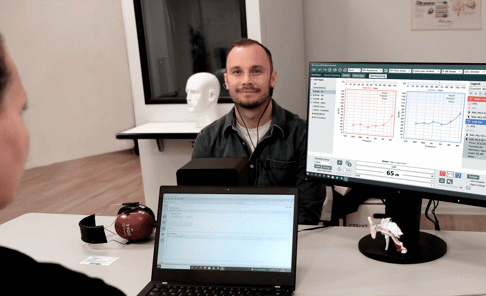
Cochlear Dead Regions

As sound travels through the inner ear, it causes vibrations along the basilar membrane within the cochlea. The basilar membrane is organized by frequency or pitch. In other words, different frequencies will vibrate maximally at specific places along the membrane. Along the length of the basilar membrane are rows of outer hair cells (OHC) which play a part in transmitting these patterns of vibration along the basilar membrane. After being detected by the OHCs, sound vibrations are detected by the inner hair cells (IHC) which form a single row along the length of the basilar membrane. The IHCs are responsible for releasing a neurotransmitter which sends sounds to the auditory nerve.
With cochlear hearing loss, the OHCs, IHCs, or both can be damaged. In hearing loss above 55 dB HL, there is most often IHC involvement. In this case, there may be sections of IHCs that are completely non-functional. These sections are often referred to as cochlear dead regions
In other words, a cochlear dead region is a specific area within the inner ear that has lost sensitivity to sound. If IHCs are not functioning at all, they are unable to release the neurotransmitter needed to send the sound to the auditory nerve. When a dead region exists in the cochlea, sounds in that frequency range cannot be detected, even if the sound is presented at a high volume. Dead regions can occur in any part of the cochlea, but they are most commonly found in the high-frequency regions. Individuals with dead regions may have trouble understanding speech, especially in noisy environments. They may also find it difficult to hear certain sounds, such as consonants or high-pitched tones.
Cochlear dead regions are difficult, if not impossible, to detect on traditional pure tone audiometry. In fact, an individual with cochlear dead regions may respond to sound presented at a high volume within that frequency range. This is because if sound is loud enough, even with non-functional IHCs in that specific frequency regions, sections of IHCs nearby to that dead region may respond. This is referred to as “off-place listening”.
Why Are Cochlear Dead Regions Important?
Cochlear dead regions can influence an individual’s success with amplification and identifying them before hearing aid fitting can help assess how likely an individual is to benefit from hearing devices. In patients with cochlear dead regions in the high frequencies, applying amplification in this range may result in distortion and diminished speech recognition. In this case, a hearing aid with frequency lowering, which we will discuss later, may be an option. Similarly, distortion may occur when amplifying low frequencies in individuals with dead regions in that range.
How To Assess Cochlear Dead Regions With TEN Testing
TEN (Threshold Equalizing Noise) testing is a diagnostic tool used to identify cochlear dead regions. It involves presenting a narrowband noise stimulus and a masking noise stimulus simultaneously to the same frequency region. Essentially, an individual’s pure tone threshold is measured in the presence of TEN noise. TEN noise was created in a way that made the threshold for detecting a pure tone in the presence of the noise at 250 – 10,000 Hz was the same for individuals with normal hearing. A dead region at a given frequency is indicated by a masked threshold that is at least 10 dB above the threshold obtained during traditional audiometry.
Frequency Lowering in Hearing Aids
Frequency lowering is a technique used in some hearing aids to address cochlear dead regions. It involves shifting the frequency range of certain sounds, such as high-pitched consonants, to a lower frequency range where the individual's hearing is still intact. This can help improve the individual's ability to understand speech and other sounds. Frequency lowering can be achieved through a variety of methods, including compression, frequency shifting, and transposition. Several hearing aid manufacturers have different forms of frequency lowering available. Using frequency lowering can also help prevent distortion that can occur by amplifying sound within an individual’s dead region.
Assessing And Managing Cochlear Dead Regions with Auditdata Measure
Cochlear dead regions can be a significant challenge for individuals with hearing loss, affecting their ability to understand speech. Identifying these regions with the TEN test can help fit hearing aids appropriately in the first appointment – no need to have patients return complaining of distortion. The TEN test takes just a few minutes per ear to complete, and the Measure audiometer makes it easy to perform when indicated.
The Measure Audiometer can quickly load audiometric test results into NOAH for quick and easy hearing aid programming. With the TEN test integrated into your software, you can seamlessly transition from TEN testing to fitting hearing aids – with or without frequency lowering.

Other Blogs You Might Enjoy:

The History of Audiometry and The Evolution of Audiometers
In short, audiometry is the study of the sensitivity of an individual’s hearing that has been performed for more than 150 years! An audiometer is a tool used to ascertain this information. This blog elaborates on the history of audiometry, and the evolution of audiometers as these are closely intertwined with not only each other but the advancement of the field of audiology as a whole.

Are Real Ear Measurements Necessary?
Real Ear Measurements (REM) – also called Probe Microphone Measurements (PMM) – are considered the gold standard in hearing aid fitting and verification, allowing audiologists to determine whether a hearing aid user is receiving the precise level of amplification needed at every frequency to maximize their hearing. This blog explains how REM can improve customers’ hearing, as well as drive better business outcomes and serve as a key differentiator for hearing clinics.

Assess OTC Hearing Devices with REM, Speech-in-Noise Testing, and Functional Gain
Demonstrating the performance of OTC hearing devices to patients can be challenging, but providing quantitative data can be helpful. REM, speech-in-noise testing, and functional gain testing can help educate patients on the appropriate use of OTC devices.
Don't Miss Out On the Latest Insights On Audiology
Sign up today to receive exciting updates, tips, and the latest newsletters from Auditdata.





